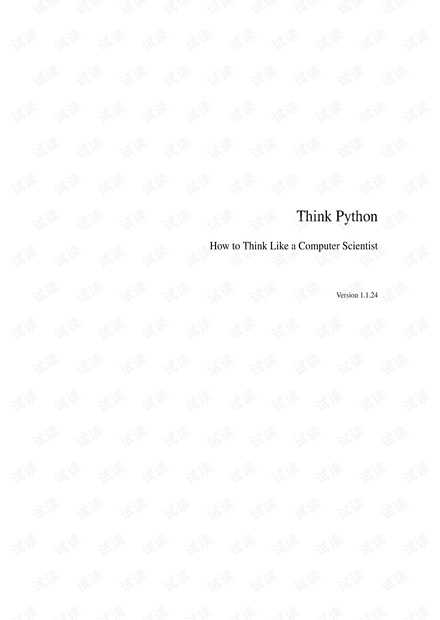没有合适的资源?快使用搜索试试~ 我知道了~
首页Think Python - How to Think Like a Computer Scientist 1.24
Python for Software Design is a concise introduction to software design using the Python programming language. Intended for people with no programming experience, this book starts with the most basic concepts and gradually adds new material. Some of the ideas students find most challenging, like recursion and object-oriented programming, are divided into a sequence of smaller steps and introduced over the course of several chapters.
资源详情
资源评论
资源推荐

Think Python
How to Think Like a Computer Scientist
Version 1.1.24


Think Python
How to Think Like a Computer Scientist
Version 1.1.24
Allen Downey
Green Tea Press
Needham, Massachusetts

Copyright © 2008 Allen Downey.
Printing history:
April 2002: First edition of How to Think Like a Computer Scientist.
Augus t 2007: Major revision, changed title to How to Think Like a (Python) Programmer.
June 2008: Major revision, changed title to Think Python: How to Think Like a Computer Scientist.
Green Tea Press
9 Washburn Ave
Needham MA 02492
Permission is granted to copy, distribute, and/or modify this document under the terms of the GNU Free Doc-
umentation License, Version 1.1 or any later version published by the Free Software Foundation; with no
Invariant Sections, no Front-Cover Texts, and with no Back-Cover Texts.
The GNU Free Documentation License is available from
www.gnu.org
or by writing to the Free Software
Foundation, Inc., 59 Temple Place, Suite 330, Boston, MA 02111-1307, USA.
The original form of this book is L
A
T
E
X source code. Compiling this L
A
T
E
X source has the effect of generating
a device-independent representation of a textbook, which can be converted to other formats and printed.
The L
A
T
E
X source for this book is available from
http://www.thinkpython.com

Preface
The strange history of this book
In January 1999 I was preparing to teach an introductory programming class in Java. I had taught
it three times and I was getting frustrated. The failure rate in the class was too high and, even for
students who succeeded, the overall level of achievement was too low.
One of the problems I saw was the books. They were too big, with too much unnecessary detail about
Java, and not enough high-level guidance about how to program. And they all suffered from the trap
door effect: they would start out easy, proceed gradually, and then somewhere around Chapter 5 the
bottom would fall out. The students would get too much new material, too fast, and I would spend
the rest of the semester picking up the pieces.
Two weeks before the first day of classes, I decided to write my own book. My goals were:
• Keep it short. It is better for students to read 10 pages than not read 50 pages.
• Be careful with vocabulary. I tried to minimize the jargon and define each term at first use.
• Build gradually. To avoid trap doors, I took the most difficult topics and split them into a
series of small steps.
• Focus on programming, not the programming language. I included the minimum useful subset
of J ava and left out the rest.
I needed a title, so on a whim I chose How to Think Like a Computer Scientist.
My first version was rough, but it worked. Students did the reading, and they understood enough
that I could spend class time on the hard topics, the interesting topics and (most important) letting
the students practice.
I released the book under the GNU Free Documentation License, which allows users to copy, modify,
and distr ibute the book.
What happened next is the cool part. Jeff Elkner, a high school t eacher in Virginia, adopted my book
and translated it into Python. He sent me a copy of his translation, and I had the unusual experience
of l earning Python by reading my own book.
Jeff and I revised the book, incorporated a case study by Chris Meyers, and in 2001 we released
How to Think Like a Computer Scientist: Learning with Python, also under the GNU Free Doc-
umentation License. As Green Tea Press, I published the book and started selling hard copies
through Amazon.com and college book stores. Other books from Green Tea Press are available at
greenteapress.com
.
剩余233页未读,继续阅读
samwise1231
- 粉丝: 0
- 资源: 5
上传资源 快速赚钱
 我的内容管理
收起
我的内容管理
收起
 我的资源
快来上传第一个资源
我的资源
快来上传第一个资源
 我的收益 登录查看自己的收益
我的收益 登录查看自己的收益 我的积分
登录查看自己的积分
我的积分
登录查看自己的积分
 我的C币
登录后查看C币余额
我的C币
登录后查看C币余额
 我的收藏
我的收藏  我的下载
我的下载  下载帮助
下载帮助

会员权益专享
最新资源
- 27页智慧街道信息化建设综合解决方案.pptx
- 计算机二级Ms-Office选择题汇总.doc
- 单链表的插入和删除实验报告 (2).docx
- 单链表的插入和删除实验报告.pdf
- 物联网智能终端项目设备管理方案.pdf
- 如何打造品牌的模式.doc
- 样式控制与页面布局.pdf
- 武汉理工Java实验报告(二).docx
- 2021线上新品消费趋势报告.pdf
- 第3章 Matlab中的矩阵及其运算.docx
- 基于Web的人力资源管理系统的必要性和可行性.doc
- 基于一阶倒立摆的matlab仿真实验.doc
- 速运公司物流管理模式研究教材
- 大数据与管理.pptx
- 单片机课程设计之步进电机.doc
- 大数据与数据挖掘.pptx
资源上传下载、课程学习等过程中有任何疑问或建议,欢迎提出宝贵意见哦~我们会及时处理!
点击此处反馈



安全验证
文档复制为VIP权益,开通VIP直接复制
 信息提交成功
信息提交成功
评论0